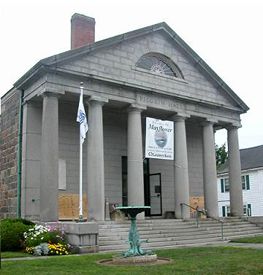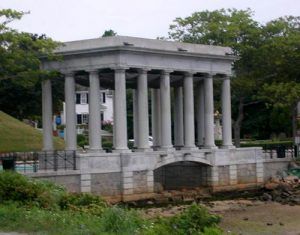The settlement of the Puritans — later to be known as “Pilgrims” — at Plymouth, Massachusetts, in 1620 looms large in the development of New England and the United States. Unfortunately, virtually all the historic sites relating to the earliest settlement period have lost their original character and convey little impression of the colony. One exception is Cole’s Hill, which is still the dominant landmark of Plymouth Harbor. The view from the hill of land harbor and sea conveys a vivid impression of the scene that greeted the Mayflower’s weary passengers.
The hill rises up from the shores of Plymouth Bay near the foot of Leyden Street, which was the principal thoroughfare of the original settlement. It was also the traditional burial place of the Plymouth colonists, Pilgrims, and others, who died during the “starving time,” the tragic first winter of 1620-21. The dead were reportedly buried at night, and their graves were disguised to prevent the Indians from learning the dangerously weakened state of the survivors. In later years, the colonists occasionally mounted cannons on the hill to ward off a possible attack from the sea.
In an early assignment of land tracts, the hill became the site of the home of Deacon Samuel Fuller, the Mayflower Pilgrims’ physician and surgeon. It was named after the popular tavern keeper who, for many years after 1645, maintained his establishment on a spot overlooking the bay.
Historically, Cole’s Hill is perhaps not as significant as other points in Plymouth, including Burial Hill, where the colony’s first fort was erected, or Leyden Street, where the settlers built the first houses. Unfortunately, these locations’ historical character and integrity have been diminished or obliterated with time and the city’s growth. The present town is encroached upon Burial Hill, filled with the graves and monuments of many generations. Cole’s Hill, however, is relatively open today and affords a sweeping view of the bay into which the Mayflower sailed and the shore on which its passengers landed.
Today, Cole’s Hill is maintained by the Pilgrim Society as a public park. On its top stands the memorial to the Mayflower Pilgrims, erected by the General Society of Mayflower Descendants. In a crypt beneath the monument are bones uncovered during excavations in the 18th and 19th centuries; because no burials were made on the hill after 1637, perhaps some are the unfortunates who braved the terrors of the ocean passage only to die in the first months of the colony’s existence. Also located on the hill is the statue of Massasoit, the Wampanoag chief whose friendship shielded the struggling colony from Indian attacks in its early years.
At the foot of Cole’s Hill is Plymouth Rock, the legendary landing site of the Pilgrims and a stepping stone to the New World. It has rested in several places over the years and has been venerated for more than two centuries, first by the people of Plymouth and later by the Nation. This great granite rock — incised with the date 1620 — commemorates the Pilgrims’ landing in New England. Resting under a portico of classical design, surrounded by an iron fence, and lying two-thirds underground, it is located at the foot of Cole’s Hill. Historians have not been able to determine whether it was the point where the first exploring party came ashore. No mention of the landing place was made in the official records of the Pilgrims. In any event, as the traditional symbol of the landing, the people of the United States venerated the rock.

Pilgrim Hall Museum.
Cole’s Hill is located on Carver Street. The Pilgrim Hall Museum, which tells the story of the Pilgrims, is located at 75 Court Street (Route 3A). The building, constructed in 1824, houses the nation’s oldest continuously operating public museum and houses an unmatched collection of Pilgrim possessions. Among its irreplaceable treasures are William Bradford’s Bible, Myles Standish’s sword, the only portrait of Pilgrim Edward Winslow painted from life, the cradle of New England’s firstborn, Peregrine White, the great chair of William Brewster, and the earliest sampler made in America, embroidered by the teenage daughter of Myles Standish.
More Information:
Pilgrim Hall Museum
75 Court Street
Plymouth, Massachusetts 02360
508-746-1620
©Kathy Alexander/Legends of America, updated February 2024.

